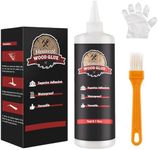Buying Guide for the Best Wood Glues
Choosing the right wood glue is essential for ensuring strong and durable bonds in your woodworking projects. The type of wood glue you select can affect the strength, drying time, and ease of use. Understanding the key specifications will help you make an informed decision that best suits your needs and the nature of your project.Type of Wood GlueThere are several types of wood glue, including PVA (polyvinyl acetate), epoxy, polyurethane, and hide glue. PVA is the most common and is great for general woodworking. Epoxy is very strong and waterproof, making it ideal for outdoor projects. Polyurethane glue is also waterproof and works well on non-porous surfaces. Hide glue is traditional and reversible, suitable for antique furniture repair. Choose the type based on the specific requirements of your project.
Bond StrengthBond strength refers to how strong the glue will hold the wood pieces together. This is important for ensuring the durability and longevity of your project. Bond strength is usually measured in PSI (pounds per square inch). For most indoor projects, a bond strength of around 3,000 PSI is sufficient. For heavy-duty or outdoor projects, look for glues with higher bond strength, around 4,000 PSI or more.
Drying TimeDrying time is the amount of time it takes for the glue to set and fully cure. This is important for planning your project timeline. Fast-drying glues can set in as little as 5-10 minutes, which is useful for quick repairs. Standard drying times range from 20-30 minutes, while some glues may take several hours to fully cure. Choose a drying time that fits your working pace and project needs.
Water ResistanceWater resistance indicates how well the glue can withstand moisture. This is crucial for projects that will be exposed to water or high humidity. Glues are often rated as water-resistant or waterproof. For indoor projects, water-resistant glue is usually sufficient. For outdoor furniture, decks, or items that will be frequently exposed to water, opt for waterproof glue.
Application MethodThe application method refers to how the glue is applied to the wood. Common methods include squeeze bottles, brushes, and syringes. Squeeze bottles are convenient for most general uses. Brushes allow for more precise application, which is useful for detailed work. Syringes can help with applying glue in tight spaces or for intricate joints. Choose the method that best suits the complexity and scale of your project.
ColorThe color of the glue can affect the appearance of your finished project, especially if the glue line is visible. Wood glues come in various colors, including clear, white, and yellow. Clear glue is ideal for projects where the glue line should be invisible. White and yellow glues are common and can be sanded and painted over. Choose a color that matches or can be easily concealed in your project.















